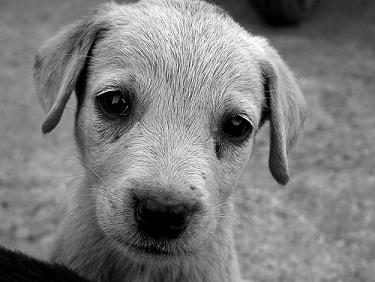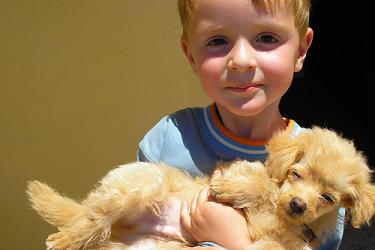DOGS WITH BAD BAD BREATH The following is a small section from 277 Secrets Your Dog Wants You To Know
by Paulette Cooper & Paul Noble. (Ten Speed Press;$8.95)
by Paulette Cooper & Paul Noble. (Ten Speed Press;$8.95)
Many dogs, especially those who eat moist food, have breath that could knock the Statue of Liberty off her perch. Dogs smell of the food they eat; and if they eat manure or fish they'll smell like it. So one solution is to change their diet, especially to dry kibbles.
Commonly, though, the source of room-clearing bad breath in dogs is bad teeth and gum problems. So have their teeth cleaned annually by the vet; brush them yourself regularly (sure); or try one of the many products sold to improve dogs' breath.To get your dog to eat that dry boring stuff, try mixing a small amount of tasty moist food in with it, microwaving the kibbles for a few seconds, or both.The above comes from the chapter, "Embarrassing Habits of Your Dog You've Been Ashamed To Ask Anyone About," which includes discussions (and what to do) about male dogs who mount and sniff you in embarrassing places, grab your leg and thrust, act nymphomaniacal, sniff & eat stool, roll around in bird droppings, and have other charming habits.
Letting your dog "kiss" you will probably not harm you; indeed, the danger may be greater to him than to you! But beware: what you might catch is rather surprising and what your dog could contract is even more astonishing.
But don't worry too much if you've got a dog who likes to leap and love and lick you. "Obviously, it's not really a sanitary thing to do, for example, dogs do sniff other dogs' fecal matter. But you probably won't get anything from that particular bacteria or others," says James B. Miller, D.V.M., from the Atlantic Veterinary College at the University of Prince Edward Island in Canada.Dr. Miller points out that one surprising disease you can catch is cat scratch disease! "Although dogs never get sick from it themselves, they can be carriers." A far more common ailment you might get from kissing your dog, though, is strep throat, which has been reported among families that have dogs and children who trade kisses back and forth.But in general, face licking is probably far riskier for dogs to do to you than for you to do to them because they can catch tuberculosis from it! And since people don't always know they have TB in the earlier stages, "They can transmit it to their dog without realizing it. They may cough, and have sputum on their lips and then the dog kisses or licks their mouth. Or they cough into a tissue, which falls to the floor and the dog chews it."The above is a small section from the chapter "Is It Safe to Let Your Dog Kiss Your Face and Should You Let Him Lick Your Feet?" which also answers such earthshaking questions as what type of dog is the most dangerous to kiss, is it safe for dogs to lick your eyes, or your feet, what diseases can you catch from your dog, why it's dangerous for children to kiss dogs, etc.
No, I'm not going to try to tell you that it's the pits to kiss a pit bull. It's the wrinkly-faced dogs that you also have to watch out for! Steven Radbill, D.V.M., believes that kissing dogs with "smushed-in" faces, like Sharpeis, Pugs, or Boston terriers can cause problems on your kisser if you try to kiss them.
These dogs "have a tendency to get Pseudomonas infections in their lip folds, and people can catch it from them. I have one client who won't stop kissing her dog and she has gotten it several times," he says.He suggests you protect yourself by checking before you let your dog kiss you by sniffing to see if his face emits a strong smell -- which indicates he may have this infection.Incidentally, to stop a dog from kissing your face, blow into his face and firmly say "no" as soon as he gets into "position."The above is a small section from the chapter "Is It Safe to Let Your Dog Kiss Your Face and Should You Let Him Lick Your Feet?" which also answers such earthshaking questions as what type of dog is the most dangerous to kiss, is it safe for dogs to lick your eyes, or your feet, what diseases can you catch from your dog, why it's dangerous for children to kiss dogs, etc.











